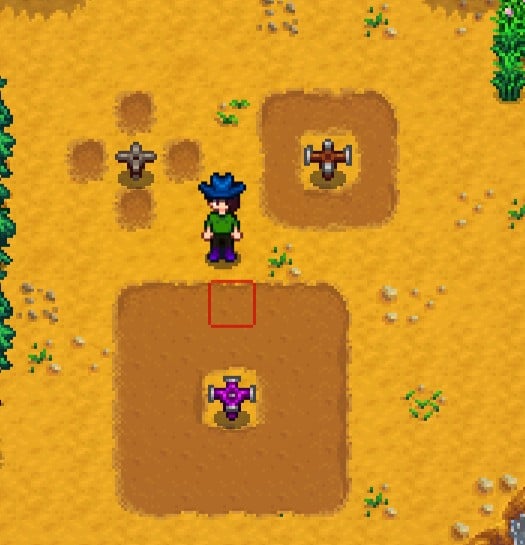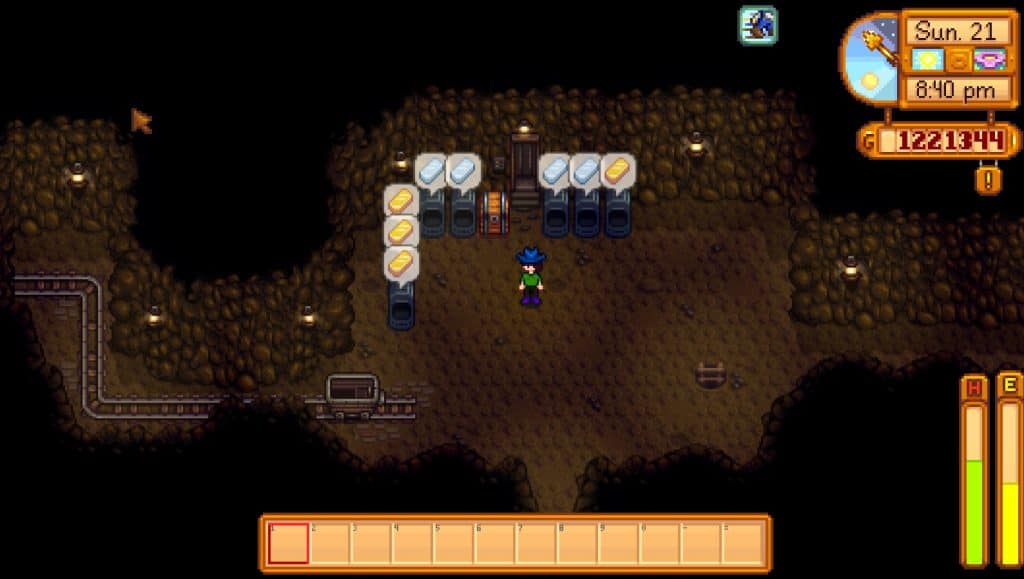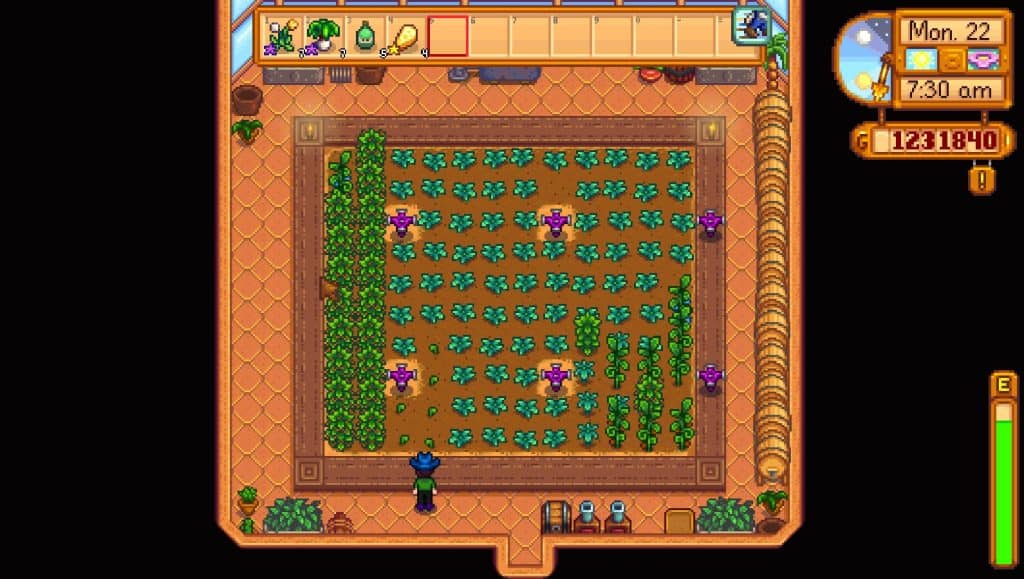As covered in our Stardew Watering Guide, the daily chore of watering all of your crops can definitely be stressful early on in the game. You need to get as many crops down as possible to get the gold comin in, but the beginning of the game is also when you have the fewest skills and the least amount of energy.
That can certainly make the first few days, weeks, or even seasons pretty challenging. The good news is that just as you can upgrade the watering can, you also have a tool that straight up automates watering your fields for you in Stardew Valley: sprinklers.
There are three types of sprinklers in Stardew Valley and each has its pros and cons. However, getting a farm loaded with sprinklers not only allows you to grow many times more crops than a farm without them, but automates the watering so you don’t have to worry about it, which is also quite fantastic.
So why doesn’t everyone use them from day one? Because they take skill levels, materials, and more to set up and use effectively. So let’s dive into not only what each sprinkler does and how to make them, but taking a big picture look at the strategies and actions that will make your life a whole lot easier on the farm.
Let’s dive in!

Basic Sprinklers Stardew Valley
Basic sprinklers are available very early, as you only need farming level two. In the picture above the sprinkler is the one that covers four crop spots, one in each cardinal direction.
This is the easiest sprinkler to get and only requires:
- Level 2 Farming Skill
- Must have found a geode to get the furnace blueprint from Clint the Blacksmith
- 1 Copper Bar
- 1 Iron Bar
Personally, I’m not a big fan of these. I don’t think they save you that much space, and require a lot of sprinklers to automate crops, or you need to manually water the spaces that aren’t automatically covered by the sprinklers.
The sprinkler layout Stardew Valley encourages for quality sprinklers and iridium sprinklers are easy squares – but this isn’t the case with a normal sprinkler setup which must be diagonal with overlap.
In addition to this, copper bars are necessary for important early upgrades while copper ore is used for building furnaces. Iron bars are necessary for quality sprinklers, so you should be saving those up until you can build quality sprinklers which give a much more practical and long lasting benefit.
While this can be a way to still automate some crops if you really, REALLY want to be elsewhere, it’s not super efficient and I firmly believe you’re better off saving those bars for basic upgrades of tools (Hello, Copper Pick Axe!)
Quality Sprinklers Stardew Valley
Quality sprinklers are where I like to start, but unless you take off developing your character in a very specific direction, you can find yourself with the skills but not the materials, or vice-versa. In fact, it’s very easy to fall into that trap, delaying your ability to grab quality sprinklers for a full season.
Quality sprinklers cover all 8 spaces around where it is placed, and are a favorite among many Stardew Players because the sooner you get 10-20 of these set down, the sooner you have mega crops and still have the time and energy to explore elsewhere and do your own thing.
A quality sprinkler requires:
- Level 6 Farming Skill
- 1 Refined Quartz Bar
- 1 Iron Bar
- 1 Gold Bar
- These can occasionally be purchased from the Traveling Cart
The Level 6 farming skill can actually be a bit of a challenge to get early if you’re not min-maxing spring for an insane amount of crops, that then get harvested for an insane amount of Strawberries. Don’t be surprised as an early player if it does take you until summer to hit, although it is absolutely possible for focused experienced players to pull it off by late spring.
This does require a sprint in the mines to at least get to level 80, since that has an elevator and level 81 is where you can start farming gold ore. Setting up multiple furnaces in the mine and a chest is the best way to farm materials and get them produced.
These automatically water 8 crops per sprinkler and make it easy to create square sections for crops. This allows for convenient field design and allows massive crop plantings without using all your time and energy throughout the day.
Mass produce these like crazy once you can. While the initial setup work can be annoying – it’s definitely worth it over the long haul.

Iridium Sprinklers
Iridium Sprinklers are amazing and straight out game-changing. Able to cover a monstrous 24 squares, six of these cover every space in the greenhouse, and a handful can absolutely transform your farm.
Consider a dozen of these outside can water 144 crops daily, automatically. That lets you scale up your farm fast, especially since you probably have 20+ quality sprinklers prior to that. I’ve even had 50 quality sprinklers by the time I could start reliably making iridium sprinklers.
If you want a lot of these year one make sure to level up that foraging skill (cut down all the trees!) because that’s what will likely trip you up as you want as many lightning rods out for summer and fall storms as possible.
This is the end goal because of how much space they automatically cover.
An iridium sprinkler requires:
- Level 9 Farming Skill
- Level 6 Foraging Skill (For lightning rods for battery packs)
- Fixed Bus (Vault Bundles in the community center – 42,500 gold)
- Skull Key (from getting to the lowest level of the mines north of Pelican Town)
- 1 Iridium Bar
- 1 Gold Bar
- 1 Battery Pack
- Can be bought from Krobus every Friday for 10,000 gold
These are the end goal however unlike quality sprinklers which can be had early in the game, you have to go deep into the skill tree and fairly deep into the original plot/game in order to get everything you need to make even a few iridium sprinklers.

Common Stardew Valley Sprinkler Questions
Sprinklers aren’t too hard to figure out once you’ve been playing Concerned Ape’s Stardew Valley for a while, but there are some things to learn along the way. Here are the answers to some of the most common because
Why are my Stardew Valley sprinklers not working?
The most common reason for this is that you have a beach farm. As beautiful and wonderful as it is, the big drawback is the sandy soil means no sprinklers. Other than the small area of normal ground behind all the trees, but most of the beach farm in Stardew is a sprinkler-free zone.
What’s the ideal quality sprinkler layout for Stardew Valley?
This one’s easy. Think big square. An increasingly big square, such as this big 24 quality sprinkler setup in the patch below a greenhouse on the forest farm (screenshot):

You always want two spaces in between quality sprinklers so you don’t get overlapping watering, which only wastes space that could be used on other crops.
Are sprinklers worth it in Stardew Valley?
Many gamers, myself included, are of the opinion that regular sprinklers are not worth it in Stardew Valley. However, quality sprinklers and iridium sprinklers are!
Sprinklers Are Life in Stardew Valley
Okay, maybe this is a little over the top, but probably not by as much as you’d expect if you’re a new player. The need for millions of gold, and the instinct to grow and expand that farm means burning an insane amount of time and energy watering crops unless you can find a way to automate the system.
Some people start immediately with the basic sprinklers but many of us just hold off until quality sprinklers are available.
Other Stardew Valley Articles You May Love
- Best Games Like Stardew Valley
- How Do I Recover Lost Tools in Stardew Valley?
- What Tools Should I Upgrade First in Stardew Valley?
- Why Are My Crops Dying Stardew Valley?
- Does Stardew Valley Have an End?
- Chicken Coop Stardew Valley

Proud to embrace the locally created moniker of “Corrupt Overlord” from one of the all time great Lords of Waterdeep runs, Shane is one member of the Assorted Meeples crew and will be hard at work creating awesome content for the website. He is a long-time player of board games, one time semi-professional poker player, and tends to run to the quirky or RPG side of things when it comes to playing video games. He loves tabletop roleplaying systems like Dungeons & Dragons, Pathfinder, Werewolf, Fate, and others, and not only has been a player but has run games as DM for years. You can find his other work in publications like Level Skip or Hobby Lark.
